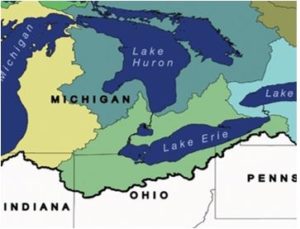June 28, 2018
 In many states there are ongoing concerns with an increasing number of harmful algal blooms (HABs) in fresh or coastal waters. One place where HABs have captured center stage in the public’s awareness, along with policymakers and the legal system, is western Lake Erie and its associated watershed, the Western Lake Erie Basin (WLEB).
In many states there are ongoing concerns with an increasing number of harmful algal blooms (HABs) in fresh or coastal waters. One place where HABs have captured center stage in the public’s awareness, along with policymakers and the legal system, is western Lake Erie and its associated watershed, the Western Lake Erie Basin (WLEB).
The WLEB is four million acres in Ohio, Michigan and Indiana; all important egg-producing states. Ohio’s governor, John Kasich, is expected to issue an “Executive Order” seeking to create a more extensive regulatory program for Ohio’s livestock, poultry and row crop producers in the WLEB in the next few weeks.
Many people and policymakers presume the cause of the HABs in Lake Erie is primarily the nutrients coming from farm fields in the basin. In 2014, HABs in Toledo’s drinking water intakes in Lake Erie caused the city to shut off the water supply for three days – some 80 million gallons per day.
Agriculture in the WLEB basin fully acknowledges that serious problems in Lake Erie exist and must be addressed: farming is the dominant land use in the WLEB and there is phosphorous from farm fields that reach the lake.
But many in agriculture, for very good reasons, are asking why is it presumed that the HABs are due only to agriculture? There are HABs occurring around the country in water bodies that have little or no agriculture in their watershed; what is causing the HABs in these locations? Scientists do not know. Neither are scientists certain about all the dynamics in Lake Erie and the WLEB itself that lead to algae blooms in general, or the conditions that flip the switch and make the blooms become HABs.
Regardless, the Ohio governor is expected to issue the Executive Order and call for greater regulation of farming. Ohio farmers will continue their efforts to find ways to reduce phosphorous losses from farm fields that could reach Lake Erie, with or without this Executive Order. But the agriculture community would feel a great deal better about the value of its efforts if the science community could confirm that farmers’ actions will help reduce Lake Erie’s HABs problems.
For video, photos and other resources, view Resources.
For media inquiries or
interview requests, contact Hinda Mitchell.